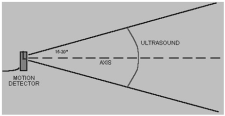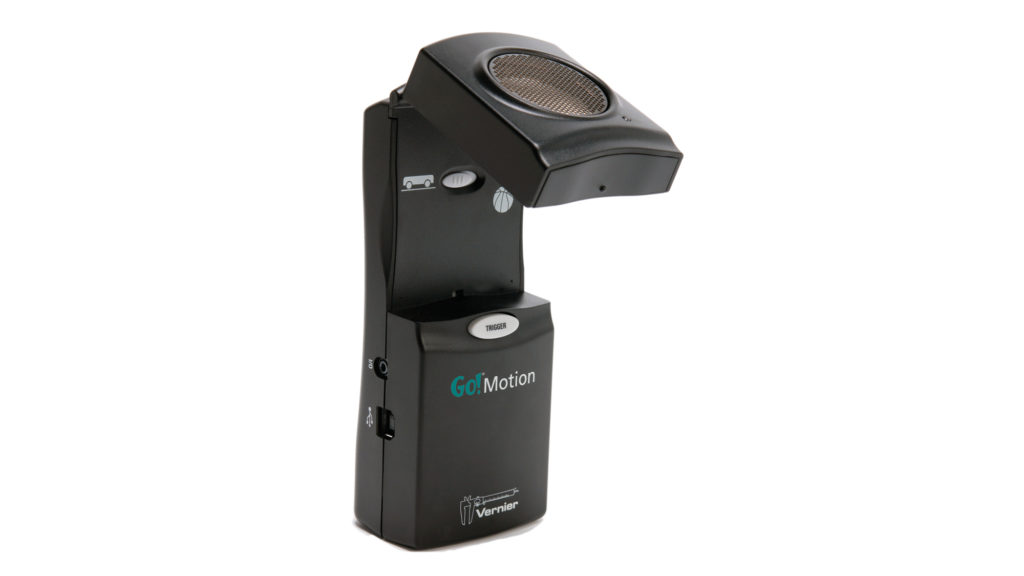Go! Motion User Manual
Order Code: GO-MOT
Go! Motion is used to collect position, velocity, and acceleration data of moving objects. Go! Motion’s USB port allows for direct connection to a computer’s USB port. Students can study a variety of motions with Go! Motion, including
- Walking toward and away from Go! Motion
- Dynamics carts moving on track
- Objects in simple harmonic motion, such as a mass hanging on a spring
- Pendulum motions
- Objects tossed upward or dropped
- A bouncing object
Note: Vernier products are designed for educational use. Our products are not designed nor are they recommended for any industrial, medical, or commercial process such as life support, patient diagnosis, control of a manufacturing process, or industrial testing of any kind.
What's Included
- Go! Motion detector
- USB cable
Compatible Software and Interfaces
Choose a platform below to see its compatibility requirements.LabQuest
Interface LabQuest App LabQuest 3 Full support 1 LabQuest 2 Full support 1 LabQuest Full support 1 Compatibility Notes
Computers
Software Interface Graphical Analysis Graphical Analysis (Web App) Logger Pro (discontinued) Logger Lite (discontinued) No interface required Full support Full support Full support Full support LabQuest Mini Full support 1 Full support 1 Full support 1 Full support 1 LabQuest 3 Full support 1 Full support 1 Full support 1 Incompatible 1 LabQuest 2 Full support 1 Full support 1 Full support 1 Full support 1 LabQuest Stream Full support 1 2 Full support 1 2 Partial support 1 3 Full support 1 2 LabQuest Full support 1 Full support 1 Full support 1 Full support 1 LabPro Incompatible Incompatible Full support 1 Full support 1 Compatibility Notes
Chromebook
Software Interface Graphical Analysis (Web App) No interface required Full support LabQuest Mini Full support 1 LabQuest 3 Full support 1 LabQuest 2 Full support 1 LabQuest Stream Full support 1 2 LabQuest Full support 1 Compatibility Notes
iOS
Software Interface Graphical Analysis Graphical Analysis GW LabQuest Stream Full support 1 Full support 1 LabQuest 3 Full support 1 2 Full support 1 2 LabQuest 2 Full support 1 2 Full support 1 2 Compatibility Notes
Android
Software Interface Graphical Analysis Graphical Analysis GW LabQuest Stream Full support 1 Full support 1 LabQuest 3 Full support 1 2 Full support 1 2 LabQuest 2 Full support 1 2 Full support 1 2 Compatibility Notes
Arduino
Software Interface Arduino Vernier Arduino® Interface Shield Full support 1 Compatibility Notes
LabVIEW
Software Interface NI LabVIEW No interface required Full support SensorDAQ Full support 1 Vernier myDAQ Adapter Full support 1 LabQuest Mini Full support 1 LabQuest Stream Full support 1 LabQuest 3 Full support 1 LabQuest 2 Full support 1 LabQuest Full support 1 Compatibility Notes
Texas Instruments
Software Interface EasyData DataMate TI-84 SmartView DataQuest TI-Nspire Software No interface required Full support 1 2 Incompatible Full support Full support 1 Full support CBL 2 Full support 3 4 Full support 3 4 5 Incompatible Incompatible Incompatible LabPro Full support 3 4 Full support 3 4 5 Incompatible Incompatible Incompatible TI-Nspire Lab Cradle Incompatible Incompatible Incompatible Full support 4 Full support 4 Compatibility Notes
Getting Started
- Connect the sensor directly to the USB port of the computer.
- Start the appropriate data-collection software (Vernier Graphical Analysis®, LabQuest® App, or Logger Pro™) if not already running, and choose New from File menu.
- Choose New or New Experiment from the file menu. If you are running Graphical Analysis in a browser, click or tap Sensor Data Collection, then choose USB. Click or tap the option that matches your interface (e.g. LabQuest), highlight your interface in the list of devices, click or tap Connect, then click or tap Done.)
The software will identify the sensor and load a default data-collection setup. You are now ready to continue your experiment.
For additional information, see
Using the Product
Connect the sensor following the steps in the Getting Started section of this user manual.
Here are some suggestions for getting good results with Go! Motion:
- Go! Motion is capable of measuring objects as close as 0.15 m and as far away as 6 m. The short minimum target distance allows objects to get close to the detector, which reduces stray reflections.
- Go! Motion has a pivoting head, which helps you aim the sensor accurately. For example, if you wanted to measure the motion of a small toy car on an inclined plane, you can lay the Motion Detector on its back and pivot the Motion Detector head so that it is perpendicular to the plane.

- Go! Motion has a Sensitivity Switch, which is located under the pivoting Go! Motion head. To access it, simply rotate the detector head away from the detector body.
- Slide the Sensitivity Switch to the right to set the switch to the Ball/Walk setting. This setting is best used for experiments such as studying the motion of a person walking toward and away from Go! Motion, a ball being tossed in the air, pendulum motion, and any other motion involving relatively large distances or with objects that are poor reflectors (e.g., coffee filters).
- The other sensitivity setting, which we call Cart, works well when studying motion of carts on tracks like the Vernier Dynamics Cart and Track System, or motions in which you want to eliminate stray reflections from objects near to the sensor beam.

Videos
Calibration
You cannot perform a traditional two-point calibration of Go! Motion. In most cases, calibration is unnecessary. You can make several adjustments to the readings by zeroing and changing the direction of the coordinate system. You can find details on how to adjust Go! Motion readings at www.vernier.com/til/2972
Specifications
|
Range |
0.15 to 6 m |
|
Resolution |
1 mm |
|
Temperature compensation |
Automatic |
|
Accuracy |
2 mm |
|
Ultrasound frequency |
50 kHz |
|
Power consumption |
51 mA |
|
Power source |
USB/DIG (Computers, LabQuest) or 4 AA batteries (Calculators) |
How the Sensor Works
Go! Motion emits short bursts of ultrasonic sound waves from the gold foil of the transducer. These waves fill a cone-shaped area about 15 to 20° off the axis of the center line of the beam. Go! Motion then “listens” for the echo of these ultrasonic waves returning to it. The equipment measures how long it takes for the ultrasonic waves to make the trip from Go! Motion to an object and back. Using this time and the speed of sound in air, the distance to the nearest object is determined.

Note that Go! Motion will report the distance to the closest object that produces a sufficiently strong echo. Go! Motion can pick up objects such as chairs and tables in the cone of ultrasound.
The sensitivity of the echo detection circuitry automatically increases, in steps, every few milliseconds as the ultrasound travels out and back. This change in sensitivity enables the detection of weaker signals.
Troubleshooting
The most frequently reported problems with a motion detector are that the motion does not work beyond a certain distance or that the graph is very noisy. There are a number of ways to troubleshoot these situations, and they are described below.
- See if the Sensitivity Switch makes a difference. Simply set the Sensitivity Switch to the other position and retry the experiment. This change may solve the problem.
- If Go! Motion does not work beyond a certain distance (e.g., it does not detect anything beyond 1.2 m), here are some things to check if you have this problem:
- Check for movable objects (textbooks, ring stands, etc.) in the cone of the ultrasound. If possible, move these objects out of the measurement cone. It may not take a very large object to cause problems.
- Check for a stationary object (chair, table, etc.) in the cone of the ultrasound. This object may be detected when you are trying to study an object farther away. It may not take a very large object to cause problems. If you have trouble with a stationary object causing unwanted echoes, try setting the equipment up so that the objects are not in the cone or placing a cloth over the object. This minimizes the ultrasound reflection.
- Also note that the cone of ultrasound extends downward from the center line. This can cause problems if you are using Go! Motion on a hard, horizontal surface. In these cases, try pivoting the head of Go! Motion to aim it slightly upward.

- Noisy or erratic data may have a number of causes. Here are some tips.
- Sometimes other sound sources can cause problems. If there is another source of ultrasonic waves in the same frequency range, this will cause erroneous readings. Examples include motors and fans, air track blowers, the sound made by the air exiting the holes on an air track, etc. Try to eliminate these sources of noise. If you are using an air track, try changing the air flow volume.
- Make sure that Go! Motion is not placed close to a computer or computer monitor.
- If the room in which Go! Motion is being used has a lot of hard, sound‑reflecting surfaces, you can get strange effects caused by the ultrasound bouncing around the room. Standing waves can be set up between Go! Motion and a sound reflector. Try placing a cloth horizontally just in front of and below the Motion Detector. This sometimes helps eliminate ultrasound that is “skipping” into Go! Motion.
- Try changing the data-collection rate. Sometimes motion detectors work better at one data rate than another. Rates above 30 Hz do not work well in acoustically live rooms.
- If you are studying people moving, have them hold a large, flat object (e.g., a large book or a pizza box) as a reflector. If you have an irregular reflecting surface, sometimes the waves will be reflected back to the transducer, and sometimes not. The results will seem erratic.
An excellent discussion of motion detector theory and operation can be found in “Physics and Technical Characteristics of Ultrasonic Sonar Systems”, Dan MacIsaac and Ari Hamalainen, The Physics Teacher 40, 39–46 (January 2002).
For additional troubleshooting tips and FAQs, see www.vernier.com/til/2115
Repair Information
If you have watched the related product video(s), followed the troubleshooting steps, and are still having trouble with your Go! Motion, contact Vernier Technical Support at support@vernier.com or call 888-837-6437. Support specialists will work with you to determine if the unit needs to be sent in for repair. At that time, a Return Merchandise Authorization (RMA) number will be issued and instructions will be communicated on how to return the unit for repair.
Accessories/Replacements
| Item | Order Code |
|---|---|
|
MD-CLAMP |
|
|
MDC-BTD |
|
|
EXT-BTD |
|
|
TI-GMUSB |
|
|
GMC-USB |
Warranty
Warranty information for this product can be found on the Support tab at www.vernier.com/go-mot/#support
General warranty information can be found at www.vernier.com/warranty
Contact Support
Fill out our online support form or call us toll-free at 1-888-837-6437.

